 Abengoa
Abengoa
Annual Report 2010
- Legal and Financial Report
- 2010 Consolidated Annual Accounts
- Consolidated Management Report
1.- Organisational Structure and Activities
Abengoa, S.A. is a technology company, and the head of a group of companies, which at the end of 2010 comprises the following companies:
- The holding parent company itself.
- 595 subsidiaries.
- 21 associates and 30 joint businesses as well as certain companies of the Group being involved in 356 joint ventures. Further, the companies of the Group have shareholding in other entities of less than 20%.
Independent from the legal organization, management of Abengoa is undertaken as discussed below.
Abengoa is a technology company which applies innovative solutions for sustainability in the following sectors: infrastructure, environment and energy, generating long-term value to our shareholders through leadership characterised by the encouragement of an entrepreneurial spirit, social responsibility and the transparency and integrity of management.
Although Note 40 of the consolidated report provides extensive information about Abengoa’s five segments, which is consistent with the internal information that has been reported to senior management for decision making until the end of this year, it is worth noting that as a result of the continuous evolution and transformation of Abengoa during more than 15 years, the management of Abengoa has begun to use financial information based on business activity and to present financial information under three new and unique business activities that, in the opinion of the management, better represent Abengoa’s business situation, and which the Company intends to use from 2011 onwards as the basis of the differentiated financial information for the Group that the management will regularly review to evaluate the operating results and to take management decisions.
In relation to this, to indicate that Abengoa, international technology company, is involved in two sectors - Energy and Environmental Services - and three lines of business – Engineering and Construction, Concession-type infrastructure and Industrial production -.
As a result, Abengoa’s activity information and its internal and external financial management information will be structured around the following business activities from 2011 onwards:
Engineering and Construction
This area encompasses core engineering activity in energy, water, and information technologies, a field in which the company boasts over seventy years of experience. Abengoa specializes in complex turnkey projects to construct concentrating solar power (CSP) plants; hybrid solar-gas facilities; conventional power plants; power transmission lines; hydraulic infrastructures, including large-scale desalination plants; and biofuel plants, among others. The company is also recognized worldwide as the leading international contractor in the field of transmission and distribution and the third largest player in power (source: ENR magazine). It is also a market leader in Information Technologies and Services for critical sectors.
Concession-type infrastructures
This segment groups together any asset operations for which we have long-term contracts in effect, including take-or-pay contracts, power or water purchase agreements and tariff-type sales contracts. This segment therefore includes solar power plants, power transmission lines, cogeneration plants and desalination facilities. There is no demand risk for these particular assets, and company efforts focus on streamlining operational aspects. Abengoa has a young asset portfolio, with an average of 27 years of envisaged operation still remaining. Furthermore, the company’s investment volume in assets currently under construction will more than double our current capacity once they begin operating.
Industrial production
This last segment embraces Abengoa activities in biofuels and industrial waste recycling. These activities, which are also performed with proprietary assets, focus on high-growth markets in which the company enjoys a position of leadership. Abengoa is the European market leader in ethanol production, and also ranks sixth in North America. In recycling, the company is the market leader in the niche markets where it operates.
2.- Strategy
2010 was yet another good year for Abengoa. In spite of the economic and financial crisis plaguing some of our markets, we continued to report double-digit growth. Revenues increased by 34 % in comparison to 2009 to total €5,566 M, EBITDA climbed by 26 % to €942 M, and net profit rose by 22 % for a total of €207 M.
Our strategy focuses on offering innovative technological solutions for sustainable development in the energy and environment sectors. Coupled with our geographic diversification, this has enabled us to report consistent double-digit growth over the last fifteen years. We believe that demand for our solutions will continue to increase as the world becomes increasingly more aware of the overriding need for sustainable development.
The two factors we consider essential in order for a solution to be accepted at Abengoa are technology, which is hugely important and affords us a competitive edge, and global leadership. We are convinced that industrial innovation is key to forging a more sustainable world. In our case, we ended the year with 99 patents that had either been granted or which were in the process of being approved.
In this regard, 2010 marked several important milestones for Abengoa, including commencement of construction of Solana, in the United States, which boasts 280 MW of installed power and six hours of molten salt storage; initiation of work on the 100 MW solar thermal power plant in Abu Dhabi, and the operational roll-out in Spain of a further three such plants, each with 50 MW of installed power.
In the biofuel area, we fulfilled our present first generation bioethanol investment plan by starting up three new plants in Illinois and Indiana (USA), and in Rotterdam (the Netherlands), with a combined annual production capacity of 300 Mgal -1,150 ML-. To this we may add the successful operation of our second-generation biomass-ethanol production plant in Salamanca, Spain.
In India, we completed construction and start-up of a desalination plant in Chennai with a capacity of 100,000 m3 per day.
Work also got underway on the 2,350 km Porto Velho - Araraquara 600 kV direct current power transmission line. Furthermore, together with twenty other partners, the company entered into an agreement to constitute Medgrid, an initiative aimed at developing and promoting a Euro-Mediterranean power grid to encourage the transmission of power produced in countries located on the southern shores of the Mediterranean to the European market.
For the first time, Abengoa features this year the three segments that best reflect the company’s reality, stemming from its evolution and transformation over the last fifteen years. The parameters guiding the company at that time are no longer valid today. Nevertheless, the bulk of this Annual Report has been structured for the last time around the company’s five traditional business units. In this Report, we have continued to gradually migrate towards the approach to reporting activities we initiated in our presentation of results for the third quarter of 2010. To this end, we have included a table illustrating the key figures in accordance with the new segment composition, as well as a summary of the Activity Report prepared from this new perspective.
We achieved significant growth this year in our three business segments (Engineering and construction, Concession type infrastructures and Industrial production).
-
Backed by 70 years of experience in the industry, Engineering and construction draws together our traditional engineering activity associated with energy, water and information technologies. We specialize in the execution of complex turnkey projects involving concentrating solar power plants; solar-gas hybrid plants; conventional generating plants; power transmission lines; hydraulic infrastructure, including, among others, major desalinating plants; biofuel plants; and critical infrastructure control systems.
- In this segment revenues totaled €3,121 M in 2010, up 26 % on 2009, and EBITDA increased by 7 % year-on-year to reach €415 M. During the past twelve months, Abengoa’s new order intake totaled €4,200 M and closed the year with a backlog of €9,274 M, which affords significant visibility for our revenues in the medium term.
- Concession-type infraestructures group together any asset operations for which we have long-term contract, including take-or-pay contracts, power/ water purchase agreements and tariff-type sales contracts. This segment therefore includes solar power plants, transmission lines, cogeneration plants and desalination plants. For these particular assets, our efforts focus on streamlining operations. We have a young asset portfolio, with an average of 27 years of pending life, and a total of €34,976 M in future income. We should also highlight the company’s investment volume in assets currently in the construction phase, which will more than double our current capacity once they enter into operation. This is a segment that affords Abengoa tremendous future exposure.
- Revenues from this segment totaled €309 M in 2010, up 41 % on 2009, while EBITDA amounted to €208 M, representing a year-on-year jump of 46 %. This high growth is primarily attributed to the operational start-up of several solar plants and desalination plants, as well as various power transmission line segments.
- The Industrial production segment encompasses Abengoa’s business in the biofuel and metal recycling area. These activities, also based onproprietary assets, are focused on high-growth markets in which the company boasts a position of technological leadership.
- Revenues from this segment totaled €2,137 M in 2010, up 48 % on 2009, while EBITDA rose by 46 % to reach €320 M. The key factors here lie in higher ethanol production as a result of three new plants in operation (two in the USA and one in Europe), which have increased our capacity to over 820 Mgal-3,100 ML- per year, as well as the recovery of recycled material volumes in Europe in the wake of a crisis-stricken 2009.
- As we can see, 44 % of our revenues and 56 % of our EBITDA in 2010 was generated by the asset operations, in comparison to 2009 figures of 40 % and 48 %, respectively, or the 19 % and 30 % of 2000, which shows the company’s evolution towards greater stability and recurrence in terms of income.
- By territory, we experienced growth in the United States, Latin America, Europe and Asia, where we witnessed the highest growth rate in percentage terms (up 81 % with respect to 2009), primarily on the back of the first major EPC contracts we secured in the Middle East and the start of construction work on a desalination plant in Quingdao, China.
Spain currently accounts for 26 % of our revenues. Brazil, with 19 %, and the United States, with 16 %, represent, respectively, Abengoa’s second and third mostimportant markets. Latin America continues as the region encompassing the highest percentage of our international business, totaling 31 %, followed by North America and Europe, excluding Spain, both with 16 %.
With these results, we managed to overcome a year characterized by the worst worldwide economic and financial crisis seen in the last 75 years, while at the same time succeeding in laying the foundations for company growth in the coming years. In fact, we continued to invest in those businesses we consider to be the focus of our strategy for the future, and, once again this year, we maintained our R&D+I efforts.
In 2010 we created Abengoa Research, an R&D group that will carry out highly innovative research for the entire company, supplementing the different R&D+I areas already in place within the organization. We also invested €93 M in R&D+I, and applied for 39 new patents. We are convinced of the importance of technology and innovation for Abengoa’s future, and we therefore continue to support these types of activities. The accomplishments achieved, which have afforded us recognition as leaders in concentrating solar power (CSP) technology and second-generation biofuel development, spur us on in the direction we decided to take many years ago.
Our human capital constitutes the cornerstone for this generation of knowledge with which we intend to continue growing. We continue toinvest in the development of our professionals.
We therefore closed 2010 with more than 1,2 M hours of training and an alliance plan in progress with some of the most prestigious universities worldwide to enable us to carry out quality training around the world. Likewise, we continued forward with our international grant program, which this year enjoyed the participation of nearly 700 people, representing an increase of 15 % over 2009. In terms of employment figures, Abengoa has grown by 12 % with respect to last year to reach a total headcount in excess of 26,000 people, thereby consolidating the growth reported in previous years.
We also continued investing in Corporate Social Responsibility to further the social development and environmental balance of the communities in which we operate, paying particular attention to the disabled and to social awareness of climate change, investing to this end more than €10 M.
In addition to completing the second inventory of greenhouse gas (GHG) emissions, we worked hard throughout the year on developing a system for labeling all of our products, which, once completed, will enable us to determine the GHG emissions associated with each and every product. We likewise kept working on the development of a system of sustainability indicators to supplement the GHG inventory.
In 2010 we obtained additional financing totaling €5,000 M approximately, which enables us to fund our investment plan to date. Through prudent administration of our financing needs, we ended the year with cash assets totaling close to €3,000 M, and with sufficiently ample leveraging levels to be able to comfortably face the coming years. Thus, net debt, excluding non-recourse financing, stood at €1,166 M at year-end 2010, 1.8 times our corporate EBITDA, while total net debt amounted to €3,122 M (excluding debt tied up in preoperational assets), 3.3 times our consolidated EBITDA.
As in 2009, with the aim of ensuring the reliability of our financial information, in 2010 we continued to reinforce our internal control structure, voluntarily adapting it to the requirements established under the US Sarbanes-Oxley Act (SOX). Once again this year, we submitted our company’s internal control system to an independent assessment process carried out by external auditors in accordance with PCAOB auditing standards.
We also remain staunchly committed to transparency and good governance practices. Our annual report already features six independent audit reports drawn up by external auditors in relation to the following areas: Annual Accounts, SOX Internal Control System, Corporate Social Responsibility Report, Greenhouse Gas Emissions Inventory, Corporate Governance Report, and the Risk Management System Design Process.
Our business model affords us greater visibility as the result of significant investment effort in recent years, which is gradually being reflected in the income statement. We ended the year with over €9,274 M in order backlog in the Engineering and construction area, a total of €34,976 M in Concession-type infraestructures, and with all of our Industrial production plants up and running.
Therefore, our main challenge in 2011 will essentially be to perform our engineering projects in due time and with sufficient margin and to continue operating our assets efficiently.
From 2013 onward, our investment plan will be reflected practically in its entirety in the income statement, once all assets currently under construction go into operation. The objective we have set for that time is to reach €1,500 M in EBITDA, which means doubling 2009 figures. And not only is EBITDA important, but also its corresponding composition and risk profile: approximately 30 % will come from Engineering and construction, 40 % from Concession-type infraestructures, and 30 % from Industrial production.
In short, 2010 was yet another year of accomplished objectives, and 2011 should prove to be another year of fresh opportunities. Our goals for the new year in terms of our three-horizon model will be to continue optimizing our cash generating activities, keep investing towards the consolidation of our businesses in high-growth sectors, expand future options and explore new ones. And all of this will take place around the focal point of technological innovation.
This is reflected in our three horizons described below.
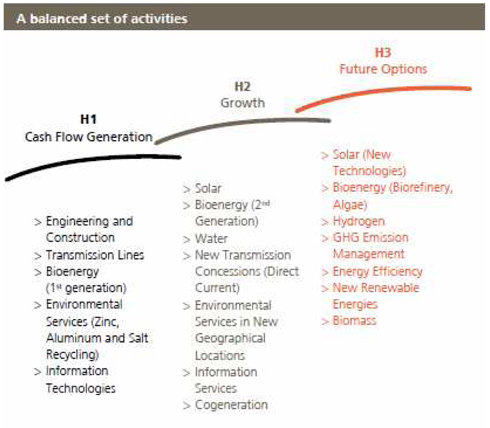
3.- Business trends
3.1. Recent trends
3.1.1. Movements in the main items on the Balance Sheet and the Income Statement are set out as follows:
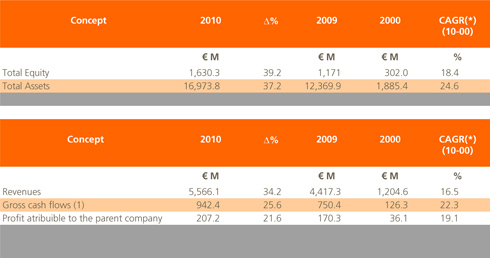
(1) Earnings before interest, tax, depreciation and amortisation.
(*) CAGR: Compound Annual Growth Rate.
3.1.2. Balance sheet; of note is an increase in “Project Fixed Assets” which rose up to €5,744.8 M in 2010, primarily being intangible assets, reflecting investments made in certain concessions in Brazil, and investments in water management projects, environmental projects and plants and production installations for Bioethanol and Solar by the various project development companies owned by the various subsidiaries Abengoa, S.A.
The investments made by these development companies are executed and financed, in general, through “project finance”, being a specific financing formula under which funds are raised exclusively to finance that entity and the project with debt repayments being made directly from the future cash flows generated by that same project. Such financing is in this reing-fenced, and is therefore without recourse to the shareholders.
The opposite entry to these investments is recognised as a liability within the Balance Sheet, as “Non-recourse financing applied to projects”, which, at the closing of 2009, amounts to
€3,558 M in non-current liabilities and to €492.1M in the corresponding short-term heading.
The net equity increased 39.2% reaching €1,630.3 M, mainly as a result of the better outcome registered in the exercise, of the positive impact of the conversion differences as consequence of the appreciation of the Brazilian Real and the increase in external partners after the sale last year of minority shares of Telvent.
The Net Debt of Abengoa in 2010 reached € ,1,265 M (net position of debt) as against the €1,271M (net position of corporative debt ) for the 2009 exercise
The change in the size and structure of the Abengoa balance sheet over the last five years reflects certain events, the impact of which is most notable on the following Balance Sheet movements:
a) Obtaining the Syndicate Loan in 2005 made up of a principle amount of €500 M with a loan term of 7 years plus a revolving facility of €100 M with a 6 year term, subscribed by 45 financial entities, structured for the purposes of providing sufficient financial resources to the company so as to implement Abengoa’s Strategic Plan.
b) The acquisition in 2006 of 100% of the share capital of B.U.S., Group AB, for consideration of €330 M, through non-recourse financing, provided through Barclays. As of December 4, the German competition authorities allowed the transaction to go ahead.
c) Obtaining a new syndicate loan in 2007 for €859 M. This loan was raised to finance Abengoa’s entry into the Brazilian ethanol market, as well as to finance our investment plans in solar energy, desalination, and electricity transmission lines.
d) Acquisition in 2007 of 100% of the share capital of the Dedini Agro group of companies (today being Abengoa Bioenergía Sao Paulo), one of the largest companies in the Brazilian sugar and ethanol market.
e) An agreement in 2007 with Matchmind, an international business, for its integration within Telvent. Through this agreement, Telvent initially acquired 58% of Matchmind for €23 M with the management team taking a 40% holding in the entity. The holding in Telvent has been increasing over the last three years until reaching 100% ownership in the 2009 exercise.
f) The acquisition in 2008 of the US entity DTN Holding Company, Inc. (DTN), with its headquarters in Omaha, Nebraska. DTN was purchased for US$ 445 million cash (approximately €310 M), and financed through a combination of preference debt and the emission of shares.
g) During 2008 the contracting of four own projects continued, being four solar thermal plants (PS 20, Solnova 1, Solnova 3 and Solnova 4), and 3 ethanol plants (Rotterdam, Indiana and Illinois).
h) The 2009 exercise saw the commissioning of the 20 MW thermosolar plant with PS 20 Tower Technology.
i) Also in 2009, Abengoa gained access to the capitals market by issuing two bonds for the total sum of €500 M.
j) Three new ethanol plants (Rotterdam, Indiana and Illinois) and three new solar-thermal plants (Solnova 1, Solnova 3 and Solnova 4) came into operation in 2010.
k) In addition, approximately €1.2 billion of bonds were issued in 2010.
3.1.3. Consolidated sales as of December 31, 2010 totaled €5,566.1 M, representing an increase of 34.2% over the last period.
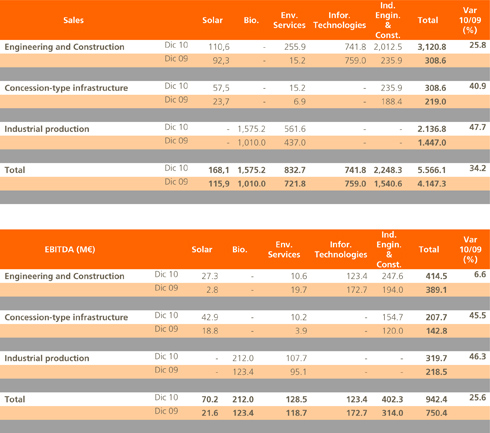
EBITDA (Earnings before interest, tax, depreciation and amortisation) increased by €192.0 million to €942.3 million, a rise of 26% compared to 2009.
This increase in EBITDA was driven by growth in the concessions activity in the infrastructures segment, which grew by 40.9% primarily due to the entry into operation of three new solar plants (Solnova 1, Solnova 3 and Solnova 4) as well as new transmission lines in Brazil. There was also a significant increase of 46.3% in the industrial production activity thanks to the coming into production of three new ethanol plants (Rotterdam, Indiana and Illinois) and a recovery in the metals recycling sector.
Once again it is important to take into account the company’s investment in R&D+i which recorded a €67.2 million impact on the income statement (€52.1 million in research and innovation expenses and €15.1 million for depreciation of development assets).
The outcome attributed to the parent company for the 2009 exercise grew by 22% reaching
€207.2 M, which amounts to €2.29 in per share benefits (22% increase as against the 2009 exercise).
Excluding the capital gain generated in 2009 of €38 million from the sale of a minority stake in Telvent, and the capital gain generated in 2010 of €46 million from the sale of two transmission lines in Brazil, the income attributable to the parent company would have increased by 21%.
3.1.4. In the 2010 exercise, Abengoa continued increasing its foreign activities in volume and in diversification. From the €5,566.1 M consolidated invoicing for the 2010 exercise, €4,135.8 M (74.3%) is from international or external sales. Activity in Spain amounts to €1,430.3 M (25.7%) as against the €1,296.4 M for 2008 (31.3%).
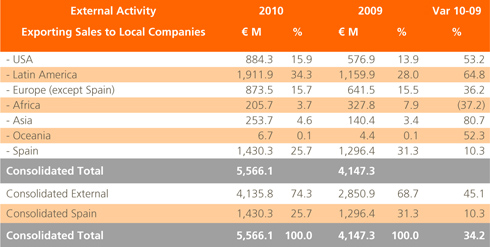
3.1.5. The following table shows the average number of employees for the various periods:

4.- Anticipated future trends of the Group
4.1. To understand the prospects of the Group, it is necessary to take into account the trends and developments achieved in recent periods, from which the foreseeable medium-term future would appear to show growth. The Group’s medium term strategy is based upon an increase in the level of contribution from Group activities within Environmental, Renewable Fuels (bioenergy), Solar activity, as well as continuing the development of Information Technologies and Industrial Engineering and Construction.
4.2. Further, Abengoa’s longer-term outlook is strengthened through increasing our capacities within the Environmental Services market, through Befesa Medio Ambiente, S.A., increased bioethanol production capacity, as well as the developments in Solar activity. On the basis that the current forecasts are achieved, Abengoa has a new activity base available which could offer both stability and continuity over the coming years.
4.3. With the current level of reserves, taking into account a greater extent of flexibility in the structure of the Group, the specialisation and diversification of activities, within the possible investments which present themselves within the domestic market and our competitive positioning within overseas markets, notwithstanding exposure of elements of our activities to the sale of commodities and non-Euro currencies, we trust that the Group shall be well positioned to continue positively into the future.
5.- Management of Financial Risk
Abengoa’s activities are undertaken through five groups which are exposed to various financial risks:
- Market risk: The Company is exposed to market risk such as the movement in foreign exchange rates, interest rates, raw material prices (commodities). All such risks arise through the normal course of business, as no operations are entered into for purely speculative purposes. For the purposes of managing such risks from these operations, we utilise a series of sale/purchase futures, exchange rate options and contracts, and interest and raw material swaps.
- Credit risk: Trade debtors and other receivables, financial investments and cash are the main financial assets of Abengoa and therefore present the greatest exposure to credit risk in the event that the third party does not comply with their obligations of the transaction.
- Liquidity risk: The financing and liquidity objectives of Abengoa are to ensure that the company has sufficient funds available on an ongoing basis so as to honour all upcoming financial commitments and obligations.
- Interest rate and cash flow risk: Interest rate risk arises from third-party long-term loans. Those loans which are granted on a variable interest rate basis expose to the Group to interest rate and cash flow risks.
Abengoa’s risk management model aims to minimise the potential Group’s financial profitability adverse effects.
Abengoa risk management is the responsibility of the Group’s Corporate Finance Department in accordance with the internal rules and procedures which are in force and strictly applied. This department identifies and evaluates the financial risks in close collaboration with each of the business units. The internal procedures provide written policies for the management of overall global risk, as well as for specific areas such as Exchange rate risk, Credit risk Abengoa risk management is the responsibility of the Group’s Corporate Finance Department in accordance with the internal rules and procedures which are in force and strictly applied. This department identifies and evaluates the financial risks in close collaboration with each of the business units. The internal procedures provide written policies for the management of overall global risk, as well as for specific areas such as Exchange rate risk, Credit risk, interest rate risk, liquidity risk, the use of hedging instruments and derivatives and the investment of excess cash.
For further information see Note 9 within the notes to these accounts.
6.- Information on Research and Development (R&D) Activities
6.1. Abengoa has continued to increase its efforts in R&D&i (Research, Development and Innovation) throughout 2010 (despite the prolonging of the global technology crisis), with a strong belief that to achieve real future benefits, such investment requires continuous input which should not be adversely affected by the crisis or economic cycles.
Further, the Group has strengthened its presence, and in other cases its leadership, in various institutions, public forums and private forums in which cooperation is encouraged between the large technology companies, also being where the long and short term future of R&D&i is decided.
6.2. The programs set out for R&D activities have substantially been achieved. Abengoa, through those responsible for the strategy in each areas of the business, has pushed, on a day-to-day basis, a higher level of innovation in the technologies developed, as required and reflected in the characteristics of the businesses, focusing primarily on the following objectives:
- Continuously and closely following the technologies which could affect each area of the business.
- Selection of a portfolio of technologies which will maximise the competitive advantages of the Group.
- The granting of and introduction of technology available through Transfer Agreements.
- Selecting the optimum path for the development of technologies.
- Determining the programs for marketing from the technology developed.
- Utilisation of support from institutions/governments for innovation and technology.
6.3. Of all such efforts, of note is that during 2010, R&D activity has been undertaken by Group companies in accordance with the requirements identified for their respective markets. The majority of the Group’s projects are aligned with R&D objectives of the Spanish administrations (the Ministry of Industry and Energy), of Europe (R&D framework programs) and the U.S. (Department of Energy).
Abengoa engages in R&D both directly as well as through third-party contracts which are typically public organisations dedicated to such work, university departments, or other private or public entities. Additionally, during the year, Abengoa has made strategic investments in pioneering companies in the US and Canada, developing and owning technologies which are defined as “high priority”, such as biofuels and control systems, with the objective of enabling internationalisation and the generation of value through these technologies in key emerging markets.
R&D is a strategic activity for Abengoa with regards to its planning for future periods. It is undertaken by the business groups in harmony with the demands of their respective markets so as to provide the necessary competitive capacities of the Group on an ongoing basis.
6.4. In 2010, investment in R&D&i totaled €93 M compared to €90 M in 2009. In 2011, a further increase in R&D&i investment is anticipated. Of note are projected investments in projects in relation to the conversions of biomass and ethanol and solar-related projects.
7.- Information on the Environment
The fundamental principles of Abengoa’s environmental policy are to comply with the legal rulings and requirements in place at any given time, the prevention of or minimisation of adverse or damaging environmental factors, the reduction of the use of natural resources and energy sources and continuous improvement in environmental behaviour.
Abengoa, in response to our commitment to the sustainable use of and natural and energy sources, as clearly set out within our Common Management Systems (NOC), stipulates that all companies within the Group are required to implement and have certified environmental management systems in accordance with international standards (ISO 14001).
As a result of implementing this policy, as of the end of 2009, 86.05% of companies within the Group (based upon sales volume) had certified Environmental Management Systems ISO 14001.
The distribution of companies with certified Environmental Management Systems by business unit is set out below:
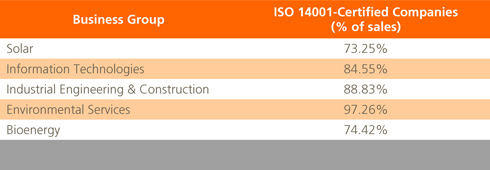
Abengoa views its tradition engineering business as nothing short of a valuable tool through which to construct a more sustainable world, being a philosophy which applies to all Business Units which make up the solar activities, biomass activities, waste activities, information technology and engineering. Abengoa applies technological solutions and innovations for sustainability.
8.- Stock Exchange Information
Abengoa, S.A. shares have been listed on the stock exchange since November 29, 1996 and the Company presents quarterly and half-year prospective information on a timely basis.
All Abengoa, S.A. shares were initially listed on the Stock Exchange in Madrid, Barcelona, and the Network Stock Exchange System on November 29, 1996, the date upon which an Initial Public Offering was undertaken (IPO) brought about by Inversión Corporativa I.C., S.A. and its subsidiary, Finarpisa, S.A., as well as other shareholder at that time.
To be able to undertake both processes (admission and the IPO) Abengoa, S.A. published a pre-issued Admission Prospectus and, together with their shareholders, a “Pre-issued initial public offering prospectus” (the IPO reporting requirements as required by the exchanges). Both documents were duly registered with the CNMV on November 12, 1996 and November 21, 1996, respectively.
The number of shares which were subject to the IPO totaled 33.03% of Abengoa, S.A.’s share capital, with the offer being completed on November 29, 1996, the date at which the listing became effective.
According to data from Bolsas y Mercados Españoles, a total of 146,655,189 shares in the company were traded in 2010, equivalent to an average daily trading volume of 572,872 shares with an average daily cash value of €10.7 million.
As of December 31, 2010, the company understands that free float capital is 43.96% if the stock shares held by Inversión Corporativa I.C., S.A. and its affiliate Finarpisa (6.041%) are substracted.
The closing price of the Abengoa share in 2010 was 18.69% lower at €18,375/share compared to 2009 (€22.60/share). The lowest, highest and average prices during 2010 were €13.22 (June 8), €24.34 (January 8) and €18.72, respectively.
9.- Information on own Equity Instruments
9.1. Abengoa, S.A. and its subsidiaries, have complied with all legal prescriptions set out relating own equity instruments (see Note 10.1 hereinafter).
9.2. The parent company has not pledged its shares in any trading operations or any other legal forms. Nor are there any Abengoa, S.A. shares held by third parties which could operate in their own name but by the responsibility, other than the responsibility of the Companies of the Group.
9.3. Certain companies within the Group are contracted into share-based incentive schemes with managers and employees. These schemes are linked to the achievement of management objectives over the following years.
Additionally, Abengoa, S.A. has a Share Purchase Plan for the directors of the Group, approved by both the Main Board of Directors and by an extraordinary shareholders meeting on October 16, 2005.
9.4. Finally, it must be pointed out that the eventual reciprocal shareholding established with entities within the Group has been undertaken on a temporary basis in compliance with the requirements of the Law of Anonymous Companies.
For further information see Note 2.16 to these notes to the Consolidated Annual Accounts.
10.- Corporate Governance
10.1. Shareholding structure of the company
Significant shareholdings
The share capital of Abengoa, S. A. is recorded and monitored by Iberclear (“Sociedad de Gestión de los Sistemas de Registro, Compensación y Liquidación de Valores, S. A.”), and is made up of 90,469,680 shares, each of €0.25 nominal value, all of the same class and rights, making up €22,617,420 of share capital. All shares are listed for trading on the Madrid and Barcelona exchanges and on the “Sistema de Interconexión Bursátil Español (stock exchange link-up) since November 29, 1996.
In December 2007, Abengoa was selected by the “Comité Técnico Asesor” (technical advisory committee) of Ibex35 to enter and form part of this index as of January 2, 2008, a listing which has been maintained throughout 2009. The inclusion was the result of the periodic review of listed companies as undertaken by the Committee, in which, as well as the company’s capitalisation, the volume of business undertaken and the sector in which the business operates is also taken into consideration. The Ibex 35 is the leading index in Spain as followed by national and international investors. The index groups together the 35 companies with the greatest listed share capital and level of business.
The most recent change to the share capital of the company was agreed at the General Shareholder Meeting on June24, 2001 relating to a shares split, from 1 Euro to 0.25 Euros per share. As such, the number of shares increased from 22,617,420 to the current volume of 90,469,680. This change required that Articles of Association 6 and 21 be amended to reflect the new volume and nominal value of the shares, and, simultaneously, the cancellation of the original shares and the admission to the exchange of the new shares.

As the company’s shares are listed, and holdings recorded with information on significant shareholder listings (the “X-25”) is provided by Iberclear, there is no other register of shareholders maintained by the company. Such information is provided by Iberclear for the Ordinary Shareholders meeting. Based upon the information received (the Iberclear list for April 11, 2010 and the notification of significant shareholders), the major shareholders at that time were:
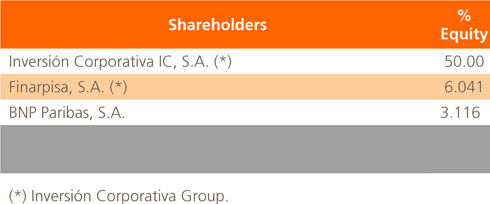
The number of shareholders registered by the “Ordinary General Annual Shareholders Meeting” as at April 11, 2010 was 11,338.
The company does not maintain a record of arrangements of agreements or pacts between shareholders of which those parties become obliged to undertake– through the voting rights which are available – being a common policy regarding the management of the company or to ensure that they have a significant influence upon the company.
In accordance with that as set out in Article 19 and pursuant to the Articles of Association, there do not exist limits upon the voting rights of shareholders in relation to the number of shares which they hold. The right to attend the shareholders meeting is limited, however, to those shareholders with over 1,500 shares, without prejudice to the rights of representation and grouping of as held by all shareholders.
Constitutional Quorum: on first notice, 25% of the share capital. On second notice any percentage. These reflect the same percentages as per the Law for Anonymous Companies. In those cases stated in Article 103 of said Law, the quorum coincides entirely with the Law.
Quorum for the adoption of agreements: by a simple majority vote by those present or represented at the Meeting. In those cases stated in Article 103 of the Law for Anonymous Companies, the quorum coincides entirely with the Law.
Shareholder rights: Shareholders have the right to information, in accordance with the applicable standards in force; the right to free delivery of the documentation related to the Shareholder Meeting; the right to vote in proportion to their shareholding, with no maximum limit; right to attend shareholder meetings if holding a minimum of 1,500 shares; economic rights (to dividends, as and when paid, and their share of company reserves); right of representation and delegation, of grouping and the right to undertake legal actions which compete to shareholders.
Active encouragement of shareholders participation: making the documentation related to the Shareholder Meeting freely available by post to shareholders, as well as announcements made on the company’s website to give notice of the Shareholder Meeting. The option to grant a proxy vote, or to vote on an absentee basis may be undertaken via the appropriate completion of accredited attendance cards. In accordance with Article 528.2 of the Capital Company Act (Ley de Sociedades de Capital), Abengoa has approved the Regulation on the Shareholders’ Electronic Forum in order to facilitate communication between shareholders regarding the notice and holding of each General Shareholders’ Meeting. Prior to each general meeting, shareholders may send:
- Proposals that they intend to submit as supplementary points to the agenda published in the notice of the general meeting.
- Requests to second these proposals.
- Initiatives to achieve the required percentage to exercise a minority right.
- Requests for voluntary representation.
The Articles of Association do not limit the maximum number of votes of an individual shareholder or include restrictions to make it more difficult to gain control of the company through the acquisition of shares.
The proposed agenda to be presented at the Shareholders Meeting is published along with notice of the meeting via the website and the CNMV.
The Shareholder Meeting matters are voted upon separately, and in accordance with the item on the agenda, when substantially distinct from one another, so that voters may exercise their views separately for distinct matters to be addressed. This is particularly of note when it concerns the appointment or ratification or an amendment to the Articles of Association.
The Company allows for the vote of shareholders’ appointed financial representatives to be split on the basis that they are acting on behalf of more than one shareholder, so that they may vote in accordance with the instructions of each individual shareholder whom they represent.
There are currently no agreements in effect between the company and its executive officers, managers or employees entitling the latter to severance pay or benefits if they resign or are wrongfully dismissed, or if the employment relationship comes to an end by reason of a public tender offer.
There is not any agreement between the company, the members of the board and employees regarding to severance pay or any other kind of compensation due to resignation or cease, or if the contractual relationship is ceased by a IPO.
Purchase of own shares
At the Ordinary Shareholder Meeting on April 11, 2010 it was agreed to authorise the Board of Directors to acquire on a secondary basis, via a contract, own shares, be it directly, or via subsidiaries or other companies in which they have a holding, up to the limit as stipulated in the agreements in force, at a price of between six cents of a Euro (0.06 Euros) and one hundred and sixty Euros and 20 cents (120.60 Euros) per share, being able to do so during a period of 18 months as of said date and in accordance with the fourth section of chapter 134 of the Amended Anonymous Company Law.
On November 19, 2007, the Company enteres into a contract with Santander Investment Bolsa, S.V. for the purposes of, without interfering with the normal development of the market and in strict adherence to the requirements of the stock exchange, improving liquidity of the shares, in a way to ensure the stability of the listing, avoiding any variations which do not reflect the trends of the market. Although this contract does not comply with the conditions as set out in the memo “Circular 3/2007” dated December 19 of the CNMV, Abengoa has voluntarily been in compliance with the requirements of “Circular 3/2007” in this regard. The operations undertaken under the scope of this Contract have been communicated on a quarterly basis to the “Stock Exchange Commission (CNMV)” and have been published on the company website.
On December 31, 2010 the treasury stock balance was 225,250 shares.
During the year, a total of 10,276,598 shares in the company were acquired, while 10,196,803 shares were sold, with a net result of €-1,144,175.71.
Details of the latest Shareholders Meeting
Abengoa’s General Shareholders’ Meeting took place on April 11, 2010, at which 59,725,210 shares were represented, equivalent to 66.016% of the total share capital, corresponding to 407 shareholders (60 present and 347 represented) of a total of 11,338 registered shareholders
Below are the decisions which were all approved by the favourable vote of the entire capital stock present or represented:
First Decision:
Approval of:
1º. The financial statements (comprising the balance sheet, the income statement and the report) and the management report of Abengoa, S.A., for 2009.
2º. The financial statements of the consolidated group (comprising the consolidated balance sheet, income statement and report) and the consolidated management report, for 2009.
3º. The work of the Board of Directors corresponding to 2009 and the remuneration of its members, as contained in the financial statements.
Second Decision:
1º. To approve the following distribution of results for the 2009 exercise with the dividends that shall be distributed from July 6, 2010 onwards:
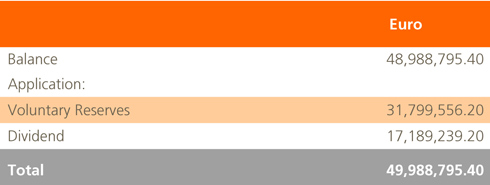
2º. To authorise Mr Felipe Benjumea Llorente, Mr José B. Terceiro and the Secretary of the Board of Directors, Mr Miguel Ángel Jiménez-Velasco Mazarío, so that any of them, jointly and severally, may register the financial statements and the management report of the Company and of the consolidated Group with the mercantile register under the conditions established by law, identifying them with their signature and verification of receipt by the register.
Third Decision:
Ratification, appointment and re-election of directors, as appropriate.
- To agree the re-election as a director, at the proposal of the Appointments and Remuneration Committee, of Ms. Mercedes Gracia Diez as an independent director, for a period of four years, due to completion of her four year term granted by the General Shareholders’ Meeting of 2006.
- To agree to ratify the appointment by co-optation of Mr Jose Borrel Fontelles, as an independent director for a period of four years, at the proposal of the Appointments and Remuneration Committee.
Fourth Decision:
Re-election or appointment of the accounts auditor for the company and its consolidated group for 2010.
Appointment of the accounts auditor of the company and its group of companies for a period of one year, for 2010, in accordance with Article 204 of the Consolidated Text of the Spanish Public Limited Companies Act, as Pricewaterhouse Coopers, S.L. with tax identification code B-79.031.290, registered in Madrid at Paseo de la Castellana, 43, registered in the Mercantile Register of Madrid under volume 9267, file 8054, number 87250, and in the Official Register of Accounts Auditors under number 50-242.
Fifth Decision:
Approval of the special report on the remuneration policy of directors and of the report relating to Article 116 bis of the Securities Market Act (Ley de Mercado de Valores).
Sixth Decision:
Authorisations of the General Meeting to the Board of Directors
To ratify the delegation of powers to the Board of Directors, pursuant to Article 153-1-b of the Consolidated Text of the Spanish Public Limited Companies Act, to increase the share capital, once or several times, up to the figure of eleven million three hundred and eight thousand, seven hundred and ten Euros (11,308,710 Euros), equivalent to fifty percent (50%) of the share capital at the time of this authorisation, by means of monetary contributions, with or without a share premium, as approved by the General Shareholders' Meeting of April 6, 2008, at the time and for the amount determined by the Board without having to consult the General Shareholders' Meeting in advance. Likewise, in accordance with Article 159, Section 2 of the Consolidated Text of the Spanish Public Limited Companies Act, the delegation of powers to the Board of Directors enables it exclude pre-emptive rights, if appropriate, in relation to the capital increases that may be agreed according to this resolution, when the circumstances in Section 1 of the aforementioned article arise, when in the Company’s interest, and provided that, in the case of such an exclusion, the nominal value of the shares to be issued, plus the amount of the share premium if appropriate, corresponds to the fair value as stated by the report of the Company’s accounts auditors drafted at the request of the Board of Directors for such purpose. Equally, the Board of Directors is authorised to redraft Article 6 of the Company’s bylaws in relation to its share capital, once the increase has been carried out, based on the amounts actually subscribed and paid up.
Likewise, to authorise the Board of Directors to apply to the governing body of the Stock Exchange (Spanish Securities Market Commission, CNMV) to list the aforementioned securities for trading on any stock exchange and to manage that listing with the intervention of any stockbroker or securities company, in relation to the shares that may be issued according to the above resolutions, when the Board deems it appropriate, pursuant to those requirements under prevailing regulations.
Shareholders’ statements with regards to this resolution shall be recorded in the minutes in accordance with Article 27 of the Regulations of Official Stock Exchanges.
Seventh Decision:
Authorisations of the General Shareholders’ Meeting to the Board of Directors
To delegate to the Company’s Board of Directors, in accordance with Article 319 of the Regulations of the Mercantile Register and the general procedure for issuing debentures, for a period of five (5) years, and with express permission to appoint any of its members, the authority to issue, on one or more occasions, any fixed income securities or similar debt instruments (including but not limited to bonds, promissory notes or warrants), as well as fixed income securities or other types of securities (including warrants) that are convertible into the Company’s shares and/or exchangeable for shares in the Company or in other companies of the Company’s group or outside the group, for a maximum amount of five billion Euros (€5.0 bn). Delegation of the authority, with express permission to appoint any of its members, to establish the criteria to determine the bases and methods for conversion, exchange or for exercising the authority to increase the share capital by the amount necessary in order to meet the corresponding demands for conversion or exercise, as well as authorisation to exclude shareholders’ pre-emptive rights in accordance with Article 293.3 of the Spanish Public Limited Companies Act (Ley de Sociedades Anónimas) and any other applicable legislation.
Eighth Decision:
Authorisations of the General Shareholders’ Meeting to the Board of Directors
To authorise the Board of Directors to make derivative acquisitions through the buying and selling of shares in the Company, either directly or through subsidiary or investee companies, up to the maximum limit established in the prevailing regulations, at a price between a minimum of six Euros (6 Euros) and a maximum of sixty Euros (60 Euros) per share, making use of this authorisation during a period of eighteen months (18) from this date, and subject to Section Four, Chapter 4 of the Consolidated Text of the Spanish Public Limited Companies Act.
The authorisation granted to the Board of Directors for these purposes by the resolution adopted by the General Shareholders’ Meeting of April 5, 2009 is hereby expressly annulled.
Ninth Decision: Delegations to the Board of Directors
Mr Felipe Benjumea Llorente, Mr José B. Terceiro and Mr Miguel Ángel Jiménez-Velasco Mazarío are hereby authorised so that any of them, jointly or severally, as special representatives of this Board, may appear before a Notary Public to grant the necessary public deeds and then register those agreements that by law must be registered with the Mercantile Registry, as appropriate, signing any documents that may be necessary pursuant to such agreements.
Likewise, to authorise the Board of Directors, with the right of appointment, so that it may freely interpret, apply, execute and implement the approved resolutions, including correcting and supplementing them, as well as to delegate to any of its members the authority to grant any deed of rectification or supplementary document that may be necessary to correct any error, defect or omission that may prevent the registration of any resolution, including complying with any requirements that may be legally required for the efficacy of such resolutions.
Since July 29, 2003 when Law 26/2003 came into effect, amending Law 24/1988 of July 28 on the securities market, and the Consolidated Text of the Spanish Public Limited Companies Act, in order to strengthen the transparency of public limited companies, the members of the Board of Directors have not held shareholdings in companies that directly carry out activities that are the same, similar or complementary to the corporate purpose of the parent company, with the exception of those described below. Likewise, they do not and have not carried out activities on their own behalf or on the behalf of others, which are the same, similar or complementary to the corporate purpose of Abengoa, S.A.
The table below lists those directors that hold positions in other listed companies:

In accordance with the register of significant shareholdings that the Company maintains, pursuant to the internal code of conduct in relation to the stock market, the percentage shareholdings of the directors in the capital of the Company as at 12/31/10 were as follows:
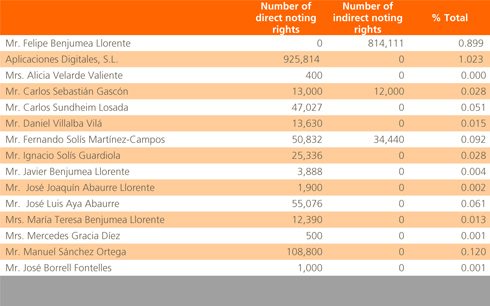
10.2. Company Management Structure
The Board of Directors
a) Composition: number and identity
Following changes to Article 39 the Corporate Bylaws, as agreed by shareholders and the Ordinary Shareholders Meeting held April 15, 2007, the maximum number of members of the Board of Directors has been set at fifteen, with respect to the nine established until that time. This modification reinforced the structure of the administration body through a number of managers that allows, on one hand, a more diversified composition and, on the other, facilitates the delegation and adoption of agreements with minimal attendance thereby ensuring a multiple and plural presence in the Board of Directors.
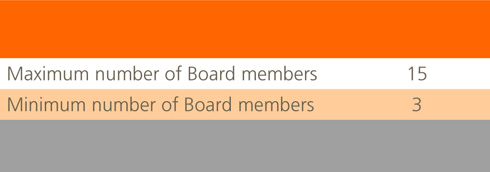
In agreement with the recommendations established in the Unified Code of Good Government of Listed Companies, the composition of the Board bears the capital structure in mind; this enables the Board to represent in a stable fashion, the highest possible percentage of the capital and ensures protection of the general interests of the Company and its shareholders. The Board is provided, moreover, with a degree of independence in concert with the practices and professional needs of any company. Its current composition is the following:
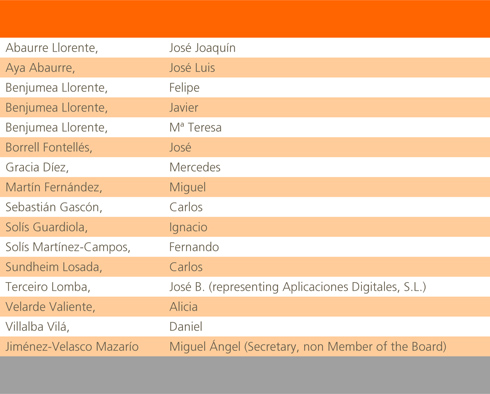
The total number of directors is considered to be adapted to ensure the necessary representation and the effective functioning of the Board of Directors.
Without prejudice that the independence is a condition that must be common to any director, without distinction due to his or her origin or appointment, basing his condition on reliability, integrity and professionalism in his or her undertakings, in agreement with the guidelines included under Law 26/2003, in the O. M. 3722/2003 and in the Unified Code of Good Governance of Listed Companies, the classification of the current directors is as follows:
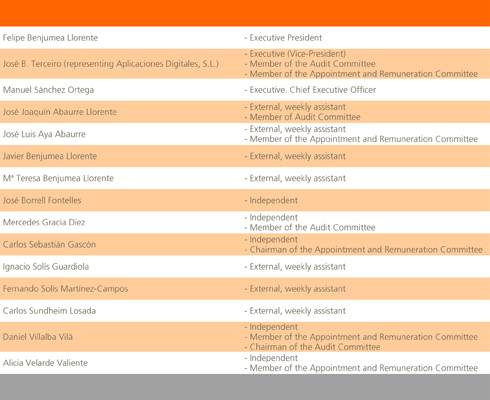
As may be seen in the table above, the Board is made up of a majority of external, non-executive directors.
b) Organisational and functional rules
The Board of Directors is governed by the Board Regulations, by the Corporate Bylaws and by the Internal Securities Exchange Code of Conduct. The Board Regulations were initially approved by the Board at a meeting on January 18, 1998, clearly in anticipation of the current rules of good governance and internal efficient application. The most recent update of note took place on June 29, 2003, in order to incorporate matters relating to the Audit Committee as established under the Financial System Reform Act.10, y previa renuncia a su cargo como consejero D. Miguel Martín Fernández, debido a la intensificación de otras ocupaciones profesionales, éste acordó el nombramiento como consejero delegado de D. Manuel Sánchez Ortega por un plazo de cuatro años, nombramiento realizado por el procedimiento de cooptación. D. Manuel Sánchez Ortega comparte las funciones ejecutivas de la compañía con D. Felipe Benjumea Llorente.
- Structure:
The Board of Directors is currently made up of 15 members. The Board Regulations cover the composition of the Board, the functions and its internal organisation; additionally, there is the Internal Stock Exchange Code of Conduct, the scope of which covers the Board of Directors, senior management and all those employees who, due to their skills or roles, are also impacted by its content. The Shareholder Meeting rules cover the formal aspects and other aspects of the shareholder meetings. Finally, the Board is supported by the Audit Committee and the Remuneration Committee, which in turn are subject to their own respective Internal Governance Rules. All such rules, included within the revised Internal Corporate Governance Rules, are available on the Company website, www.abengoa.com.
Since its inception, the Remuneration Committee has been analysing the structure of the governing bodies of the Company and has worked to align such bodies with regulations in force regarding governance, focusing in particular on the historical and current configuration of such ruling bodies within Abengoa. Consequently, in February 2007 the committee recommended the creation of a Coordination Director, as well as the dissolution of the Advisory Committee to the Board of Directors. The first recommendation was to align the Company with the latest corporate governance recommendations in Spain in 2006; the second recommendation reflected that the advisory board had completed the role for which it was established in the first place, and that its coexistence with the remaining company bodies could create a potential conflict of roles. Both proposals were approved by the Board of Directors in February 2007 as well as by the shareholders at the ordinary general meeting on April 15 of the same year.
Finally, in October 2007 the Committee proposed to the Board the resignation of Mr. Javier Benjumea Llorente as Vice-president, along with the revoking of any powers which had been granted, and the naming of a new representative, being an Abengoa representative, being an Abengoa representative, or a Focus-Abengoa Foundation representative, for all those entities where he would have a responsible post.
On the basis of the foregoing, the committee decided that it would be opportune to repeat the study on numbers and conditions of the vice-president to the Board of Directors within the current structure of the company’s governing bodies.
As a result, the Committee considered it necessary that the vice-president of Abengoa hold the powers as per the Law for Anonymous Companies so that, on the one hand, he or she is granted full representation of the company and, on the other, the functions of the president of the board. On this basis it was considered that the Coordinating Director – in accordance with the responsibilities as assigned to the role by the Board of Directors (February 2007) and at the Shareholder Meeting (April 2007) – was ideal for the role, in addressing the corporate governance recommendations and the structure of the company, as well as the composition and diversity of the directors. The coordination director already has the duty to take into account the concerns and goals of the board members and, to achieve this, has the power to call Board meetings and to add items to the agenda. As this role was more in substance than in title, considered the interests of the directors, and reflected a certain representation of the Board, it was considered appropriate to recognise this institution and comprehensive representation.
For the reasons mentioned, the Committee deemed it appropriate to propose Aplicaciones Digitales, S.L. (Aplidig, represented by Mr. José B. Terceiro Lomba), the current Coordination Director, as the new Vice-President of the Board. Additionally, within the representative duties, it was proposed that the vice-president, in conjunction with the president, would represent Abengoa as president of Focus-Abengoa Foundation, as well as for other foundations and institutions in which the company is or should be represented.
In light of the above, on December 10, 2007 the Board of Directors approved the appointment of Aplicaciones Digitales, S. L. (represented by Mr. José B. Terceiro Lomba), the current Coordination Director, as the new Vice-President of the Board, with unanimous consent of the independent directors regarding the retention of his role as coordination director despite being promoted to an executive board member role. Additionally, within the representative duties on July 23, 2007, the Board approved that the vice-president, in conjunction with the president, would also represent Abengoa as Chairman of the Focus-Abengoa Foundation Board, as well as for other foundations and institutions in which the company is or should be represented.
The Chairman of the Board, as the leading executive of the Company is granted full powers excluding those which by law are not assignable to the Board of Directors regardless the Board-attributed faculties and competences. With regards to the vice-president, also an executive role, he or she holds at the same time power over the aforementioned faculties.
At the proposal of the meeting of the Appointments and Remuneration Committee of October 25, 2010, and due to the resignation as a director of Mr Miguel Martín Fernández due to other professional commitments, the Committee agreed to appoint Mr Manuel Sánchez Ortega as CEO for a period of four years, by co-optation. Mr Manuel Sánchez Ortega shares the executive functions of the Company with Mr Felipe Benjumea Llorente.
- Functions:
The role of the Board of Directors is to undertake the necessary actions so as to achieve the corporate objectives of the Company. It is empowered to determine the financial goals of the company, agree upon the strategies necessary as proposed by senior management so as to achieve such goals, assure the future viability of the company and its competitiveness, as well as adequate leadership and management, supervising the development of the Company’s business.
- Appointments:
Shareholder meetings, or when applicable the Board of Directors, within the established rules and regulations, are designated the authority to appoint members of the Board. The appointee will be required to demonstrate that they have the necessary legal requirements, that they are trustworthy and that they have the required knowledge, prestige and sufficient professional references so as to undertake the functions of director.
Directors are appointed for a maximum of 4 years, although may then be re-appointed.
- Cease of directors:
Directors will be removed from their position at the end of their tenure or under any other circumstances in accordance with the appropriate laws. Further, they should relinquish their role as Directors in the event of any incompatibility with, prevention of, a serious charge against, or non-compliance with their obligations as Directors.
- Meetings:
In accordance with Article 42 of the Company Bylaws, the Board of Directors will meet as deemed necessary given the demands of the Company or, as a minimum requirement, three times annually, with the first meeting during the first quarter of the year. During 2010, the Board met a total of 15 times, in addition to a meeting between the Board of Directors and senior management.
- Duties of the Directors:
The function of the director is to participate in the direction and control of management of the Company for the purposes of and with the aim of maximising its value for shareholders. Each director operates with the diligence and care of a loyal and dedicated professional, guided by the company’s interests, as a representative with complete independence to defend and protect the interests of the shareholders.
By virtue of their appointment, the directors are required to
- Prepare and be sufficiently and properly informed for each meeting.
- Actively assist and participate in the meetings and decisions.
- Avoid conflicts of interest and, in the event that they arise, to communicate such conflicts to the Company through the Board of Directors’ Secretary.
- Not to undertake duties for competing entities.
- Not to use Company information for personal purposes.
- Not to use the Company’s business opportunities for their own interest.
- Maintain full confidentiality regarding information received within their role as Director of the Company.
- Abstain from voting on proposals that may have an effect on them.
- The Chairman:
The Chairman, in addition to the Company Bylaws and legal requirements, is the senior-most executive of the Company, and as such is effectively responsible for the management of the Company, in accordance always with the criteria and decisions of the Board of Directors and the Shareholder meetings. The Chairman is responsible for implementing the decisions made by the company’s management bodies, through application of the powers as permanently granted to him by the Board of Directors, which he represents in all aspects. The Chairman also casts the deciding vote on the Board of Directors.
The Chairman is also the Chief Executive Officer. The following measures are in place to prevent an accumulation of power.
Under Article 44 bis of the Company Bylaws, on December 2, 2002 and February 24, 2003 the Board of Directors agreed to appoint the Audit Committee and the Appointment and Remuneration Committee.
These committees have the powers, which may not be delegated, as per the Law, the Company Bylaw and internal regulations, acting as regulatory body and supervisory body associate with the matters over which they chair.
Both are chaired by a non-executive independent director and are comprised of a majority of non-executive directors
- The Secretary:
The Secretary to the Board of Directors undertakes those responsibilities as required by law. Currently the role of Secretary and that of Legal Counsel to the Board is undertaken by the same person, being responsible for the correct calling of meetings and that resolutions are properly implemented by the Board. In particular, he will advise the Board as to the legality of proposed deliberations and decisions and upon compliance with the Company’s internal corporate governance regulations, making him responsible as a guarantor of the legality, both in law and in substance, of the actions of the Board.
The Secretary, as a specialised role, guarantees the legality in law and in substance of the actions of the Board, with the full support of the board to perform their duties with independent judgement and substance. He or she is also responsible for safeguarding the internal rules of corporate governance.
- Resolutions:
Decisions are made by a simple majority of those directors present at the meeting (present of represented) in each meeting, with the exception of legal matters as previously set out.
c) Compensation and other benefits
- Salaries:
Directors are remunerated in accordance with Article 39 of the Company Bylaws. The director’s remuneration may consist of a fixed amount as agreed at the Shareholders Meeting, and need not be equal for all directors. Additionally they may receive a proportion of retained earnings of the Company, of between 5 and 10 percent, maximum, of earnings after dividends in the year to which the remuneration relates. Additionally, costs of relocations are recovered, if undertaken as part of their role as Director.
The total remuneration paid during 2010 to the whole of the Board of Directors was€8,912,000 for fixed and variable remuneration concepts including expenses, (2.2% higher than 2009) and €137,995 for other concepts.
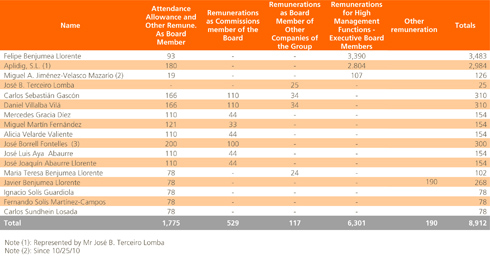
Additionally, during 2010 the remuneration paid to the Company’s senior management team, as shown below (members of the senior management team that are not executive directors, indicating the total remuneration paid to them during the year) for all concepts (fixed and variable) totalled €7,216,000.
In addition, the remuneration paid to the High Management staff of the Company as such during the 2009 exercise, (members of the high management who are not executive board members with indication of the total remuneration accrued for them during the exercise), amounted, in all the concepts, both fixed and variable, to €6,883,000.
For more information on the Corporate Governance Report, the appendix of this Management Report contains the complete version which has been subjected to independent verification by our auditors who have issued opinion of reasonable assurance based on the ISAE 3000 standard “Assurance Engagements other than Audits or Reviews of Historical Financial Information” issued by the International Auditing and Assurance Standard Board (IAASB) of the International Federation of Accountants (IFAC).
11.- Appointments and Remuneration Committee
11.1. Introduction
The Appointments and Remuneration Committee was constituted by the Abengoa, S. A. Board of Directors on February 24, 2003, under the scope of Article 29 of the Rules of the Board of Directors, for the purposes of incorporating the recommendations, regarding said committee, of Law 44/2002 of Financial System Reform. The Board also approved the Internal Regime Regulation.
11.2. Composition
The Composition of the committee is as follows:

The Secretary was appointed to the Committee on January 28, 2004 by written agreement without Committee meeting; the president was appointed to the Committee on October 19, 2006.
As such, the Committee is made up of one executive director and four non-executive directors, with which it complies with the requirements of the Financial System Reform law. Additionally, as set out in Article 2 of the Internal Rules, it is required that the President of the Committee is a non-executive appointment.
11.3. Duties and Functions
The duties and functions of the Appointments and Remuneration Committee are:
1. To inform the Board of Directors of appointments, re-elections, terminations and remunerations of the Board and its members, as well as upon general remuneration and incentives policy for the Board and senior management.
2. To inform the board of Directors, with advanced notice, all appointments or removals proposed by directors at the Shareholder Meeting, even in case of co-optation by the Board of Directors; annually verify that the strict conditions necessary for the appointment of a director are maintained (the character and nature of those assigned), preparation of information which will be included within the annual report. The Appointments and Remuneration Committee will oversee that, to fill vacancies, the selection process is not affected by implicit bias which may stand in the way of the appointment and that the potential candidates include women which fit the required profile.
3. To prepare an annual report on the activities of the Appointments and Remuneration Committee, which is to be included as part of the Management Report.
Meeting and the calling of meetings
To comply with the aforementioned duties, the Appointments and Remuneration Committee will meet when necessary and, as a minimum requirement, once every half year. They will also meet at any time at the discretion of the chairman. The meeting will be valid only once all members that are present and agree that the meeting is in progress.
The Committee met six times during 2010. Important issues discussed at these meetings included proposals to appoint or re-appoint members of the Board of Directors and appointments of members of the International Advisory Committee of the Board of Directors, as well as ensuring that the appropriate conditions have been met in appointing directors and with regards to their suitability and classification.
11.4. Quorum
The committee is considered to be quorate when the majority of its members are present. The delegation of attendance may only be granted to a non-executive member.
A decision or resolution requires the majority vote, in favour, of all those present or represented. In the event of a tie, the chairman shall cast the deciding vote.
Acting as secretary, the Company Director of Remuneration will also attend the meetings.
Analysis and proposals made by the Committee
- Monitoring and evolution of the remuneration of the members of the Company’s Board of Directors and senior management.
- Proposals for the remuneration of members of the Company’s Board of Directors and senior management.
- Preparation of the corresponding information to be included in the financial statements.
- Proposal to the Board of Directors to appoint, by co-optation, Mr Manuel Sánchez Ortega as director, following the resignation of Mr Miguel Martín Fernández.
- Proposal to the Board of Directors to re-elect Ms. Mercedes Gracia Diez as a director, following the end of her previous term.
- Proposal to the Board of Directors, to be presented to the next General Shareholders’ Meeting, to ratify Mr Manuel Sánchez Ortega as a director, previously appointed by co-optation (10.25.10) as an executive director.
- Proposal to the Board of Directors to approve the annual report on the directors’ remuneration policy.
- Report to verify that the conditions for appointing directors, their characteristics and the type of directorships, have been met.
- Presentation to the Board of Directors of the report on the remuneration of members of the Board of Directors and the CEO.
- Reports on market studies carried out by independent experts and remuneration comparisons.
- Analysis on the remuneration of executives of different companies of the Group.
12.- Further Information
To correctly measure and value the business and the results obtained by Abengoa, it is necessary to draw out the business trends from the consolidated figures.
In addition to the accounting information, as provided within the financial accounts and within this management report, Abengoa also publishes an “Annual Report” which sets out the key events of 2010. This report is available in Spanish, English and French. The Annual Report, which is published prior to the shareholder meeting at which the financial statements of 2010 will be approved, includes not only the consolidated accounts of Abengoa, as well as the strategic objectives of the business and the key events of the five Business Units into which Abengoa is structured as of December 31, 2010.
The annual report is available on the Company’s website at www.abengoa.com.
The requirement to provide the market with information which is useful, truthful, complete, comparable and up-to-date would not be of such value to the user if the means of communicating such information were insufficient, as it would result in such information not being as effective, timely and useful. As such, the Aldama Report, the Financial System Reform Law and the Transparency law recommend and enforce, in the light of recent technologies, the use of a website by listed companies as an information tool (including historical, qualitative and quantitative data on the company) and a means of disseminating information (on a timely or real-time basis, making such information available to investors).
Abengoa has a website, which was recently renewed and updated, that features far-reaching and comprehensive content, including information and documentation made available to the public and, in particular to shareholders. This website offers periodic information (quarterly and half-yearly) as well as other relevant information and facts upon which it is mandatory that Abengoa report to the CNMV to comply with the rules of the stock exchange. Through this website, it is also possible to request a copy of the Annual Report.
13.- Events after the end of the year.
Following the close of the financial period no events have arising or occurred which could significantly influence the information as reflected in the consolidated financial statements as prepared by the Company with this date, or which stand out due to being particularly of note or importance